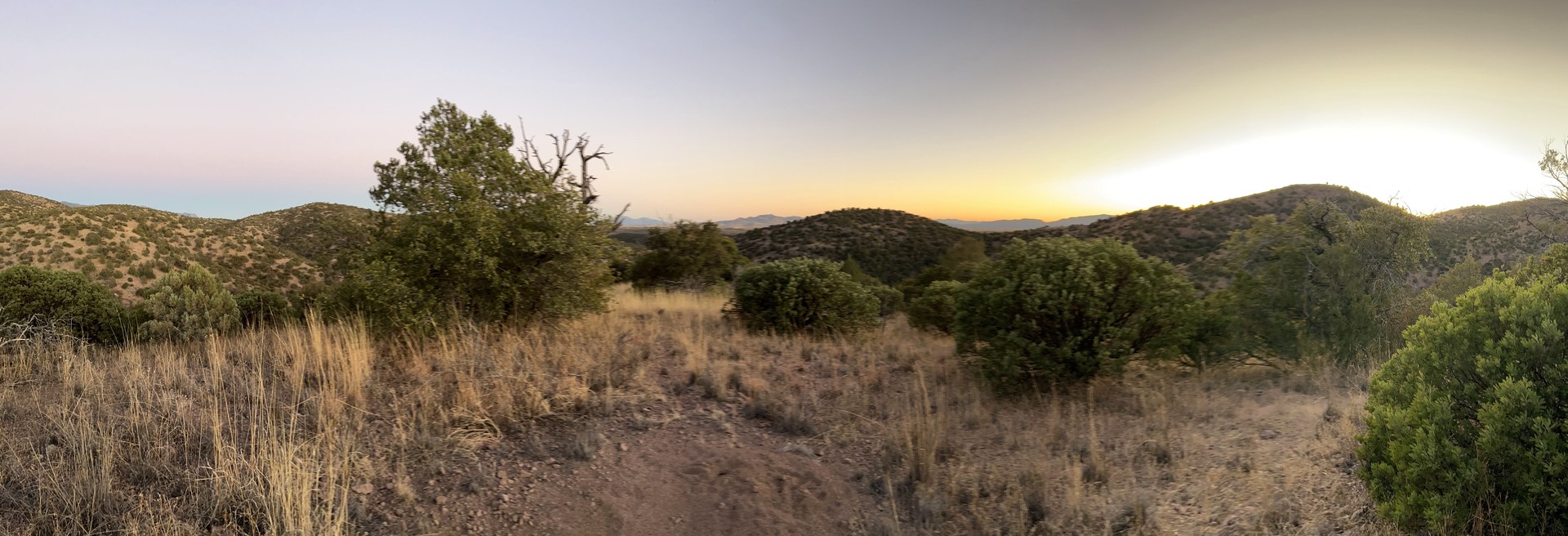You are here
Parker Canyon Lake to Middle Canyon Loop is a 20-mile route from Parker Canyon Lake, venturing through the scenic Arizona Trail across the Canelo Hills, and winding through Middle Canyon. This loop route incorporates single-track trails and dirt road paths, crosses Pauline Canyon, and includes a section of the Short Turkey Road before reconnecting with the Arizona Trail to complete the circuit. Designed for the adventurous hiker, this trail offers a deep dive into the diverse landscapes and tranquil wilderness of Southern Arizona.
This route offers an exceptional opportunity to explore the rugged beauty and serene landscapes of Southern Arizona. With its combination of well-marked trails and less-traveled dirt roads, this route promises an adventure filled with natural wonders, challenging hikes, and peaceful solitude.
ROUTE DESCRIPTION
Your adventure starts at Parker Canyon Lake, where the trailhead leads you onto the Arizona Trail, renowned for its breathtaking vistas and diverse ecosystems. As you move through the Canelo Hills, the trail offers a stunning display of the area's natural beauty, from rolling grasslands to dense oak woodlands.
Upon reaching Middle Canyon, the landscape opens up to reveal sprawling valleys and rugged canyon walls. This section provides a serene backdrop for a mid-hike rest.
The loop continues as you venture off the Arizona Trail onto dirt road paths that ascend into Pauline Canyon. This rugged terrain challenges your stamina but rewards you with panoramic views and a sense of solitude rarely found on more traveled paths.
Connecting with the Short Turkey Road, you'll experience a more intimate view of the region's flora and fauna. This lesser-known trail offers a unique perspective of the Southern Arizona wilderness before linking back to the Arizona Trail.
The final leg retraces your steps along the Arizona Trail, heading back towards Parker Canyon Lake. This return journey allows you to take in the vistas and landscapes from a new angle, cementing the day's experiences in your memory.
Best Time to Visit: Fall to spring, when temperatures are cooler and the landscape is lush from seasonal rains.
CAMPING
-
Dispersed camping is available along the Arizona Trail and within designated areas. Ensure to follow Leave No Trace principles and camp at least 200 feet away from water sources and trails.
-
No formal campgrounds are on this route, so be prepared for backcountry camping conditions.
PERMITS AND REGULATIONS
-
No specific permits are required for hiking or camping along this route in the Coronado National Forest. However, always check for the latest information on fire restrictions, wildlife closures, and other regulations before your trip.
SAFETY CONSIDERATIONS
-
Water sources may be scarce along the route, especially outside of the rainy season. Carry sufficient water and a means to purify any water you may find.
-
Be prepared for variable weather conditions. Pack layers, sun protection, and rain gear to adapt to changing temperatures and conditions.
-
Given the loop's remote sections, ensure someone knows your hiking plans and expected return time.
TRAILHEAD INFORMATION
Parker Lake, also known as Parker Canyon Lake, is located in the southeastern part of Arizona. It covers approximately 130 acres and is situated at an elevation of around 5,400 feet, making it a cool retreat during the hot summer months.
Parker Canyon Lake is a popular destination for a variety of outdoor activities, including: fishing, boating, hiking, bird watching, and camping.
Facilities: The lake features a boat launch area, a fishing pier, and a small marina where visitors can rent boats. The Lakeview Campground near the lake offers developed campsites with basic facilities.
Wildlife:The area around Parker Lake is rich in wildlife, including deer, javelina, and various species of birds. Its unique ecosystem supports a rich biodiversity, making it an excellent place for nature enthusiasts.
Access and Regulations:Parker Canyon Lake is accessible by car via a well-maintained road that leads directly to the lake. Visitors should be aware of the Coronado National Forest regulations to protect the area's natural beauty and wildlife. Fishing licenses are required for anglers, and all state and federal fishing regulations apply.

















Comments
Sign In and share them.